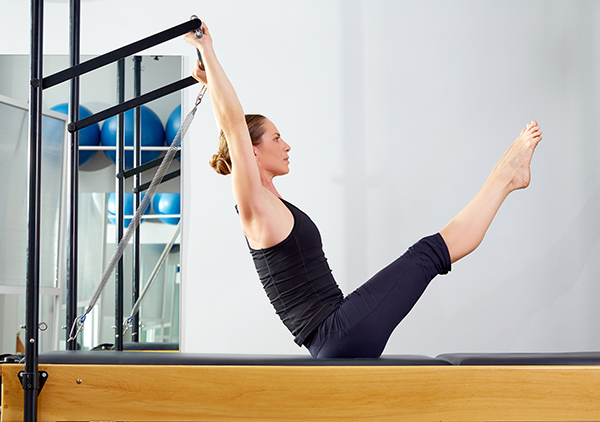Forty years ago, Pilates was a backwater exercise method practiced by about 5,000 people in the United States. Today, millions of people around the world do Pilates and most gyms have dedicated Pilates instructors and classes. Joseph Pilates developed Pilates exercises in the 1920s, based on work of fitness gurus of the time, such as Eugene Sandow. The method includes more than 500 exercises done on modified gymnastics devices or without equipment. Is it effective, and how does it compare with other exercises? A study by Michelle Olson from Auburn University, Montgomery provided some good news for Pilates lovers along with a few warnings.
Pilates: A Moderate Intensity Exercise for Better Health
Pilates will not prepare you to compete against Olympic athletes. Only three intermediate-level Pilates workouts per week, however, will satisfy the exercise guidelines from the U.S. Department of Health and Human Services. In general, healthy adults should do at least 150 minutes of moderate intensity aerobic exercise (e.g., brisk walking) or at least 75 minutes of vigorous intensity exercise (e.g., jogging) per week. Most health benefits of exercise occur at the lower levels of physical activity – progressing from sedentary to moderate activity. Increasing the volume and intensity of exercise boosts the benefits but not to the same extent as going from nothing to a small amount. Moderate-intensity Pilates workouts will boost metabolic health that will help process fuels better, boost heart health, and promote longevity.
Dr. Olson’s study showed that intermediate-level Pilates workouts burned about 6 calories per minute, which is equivalent to low-impact cardio and meets government exercise standards. Advanced Pilates boosts caloric expenditure to 7.5 calories per minute, which is equivalent to brisk walking. Pilates increases heart rate and metabolism best by minimizing rest time between exercises.
Pilates Works the Core
While Pilates is not as good as jogging, cycling, or brisk walking for cranking up the metabolism and building aerobic fitness, it is excellent for building the core – the muscles in the center of the body that support the spine, making you look good, and that transfer force during whole-body movements.
The Auburn University study, using a technique called electromyography (EMG), showed that 10 repetitions of the Pilates hundred, roll up, and double-leg stretch exercises activated the deep abdominal muscles (i.e., internal obliques and transversus abdominis) better than 10 standard crunches, and did a decent job of exercising the rectus abdominis – the six-pack muscle. However, researchers from Azusa Pacific University in California, led by Dr. Jerrod Petrofsky, found that muscle activation (also measured by EMG) was the same during Pilates performed on a “Zone Pilates Sculpture” as during machine-based weight training exercises. Pilates was excellent for building muscle endurance but activated the core muscles poorly. Adding resistive devices (bands and wands) to the Pilates exercises dramatically increased muscle activation in lower body muscles. Pilates exercised several joints and muscle groups simultaneously, which boosted training efficiency.
The Downside of Pilates
While Pilates was designed to promote back health, some of its exercises can damage the spine and cause back pain – particularly when done incorrectly. Some Pilates instructors have little training beyond a weekend workshop and practical experience in Pilates classes. The spine, hips and knees are complex and vulnerable. Poorly performed Pilates exercises can do more harm than good.
Find a Pilates instructor with a personal training certificate from a credible organization, such as the American College of Sports Medicine (ACSM), International Sports Science Association (ISSA), or the National Strength and Conditioning Association (NSCA). The most knowledgeable trainers typically have college degrees in kinesiology, exercise science or physical education.
Extensive research by Canadian spinal biomechanist Stuart McGill (https://www.backfitpro.com/) demonstrated that maintaining a neutral spine and avoiding excessive trunk flexion (trunk bent forward) during exercise protects the back and neck from injury. Some Pilates exercises load the spine with the trunk flexed (bent), which can trigger back pain.
The abdominal muscles often act to prevent motion, yet we usually build them with trunk flexion exercises such as sit-ups or leg raises, both of which can injure the spine. Several popular Pilates exercises, while excellent for strengthening core muscles, also place excessive stress on the low back or neck. Dr. Olsen was particularly concerned about Pilates exercises that place excessive stress on the neck, such as the roll-over and jack-knife; those that flex (bend) the back to extremes in the range of motion, such as the swan dive and rocking; and exercises that overuse the hip flexors (muscles that move the thigh toward the chest), such as the roll-up and the teaser. Excessive hip flexion places too much stress on the disks in the low back. Intense Pilates exercises that alter the spinal curves throw the baby out with the bathwater. They build strong core muscles but set the stage for serious and chronic back and neck injuries.
Get Moving With Pilates
Pilates will not turn you into a fitness model, but it will improve muscle tone, contribute to health, increase energy levels and might help you live longer. Get moving! Hire a personal trainer or coach for a couple of hours, learn the proper techniques, and then sign up for a Pilates class. Today is a good time to get moving!
References:
Beck, R. Getting to the core. Using Pilates to promote overall wellness during rehabilitation. Rehab Manag, 21:34, 36, 2008.
Curnow, D., D. Cobbin, J. Wyndham, and S. T. Boris Choy. Altered motor control, posture and the Pilates method of exercise prescription. J Bodyw Mov Ther, 13:104-111, 2009.
Endleman, I. and D. J. Critchley. Transversus abdominis and obliquus internus activity during Pilates exercises: Measurement with ultrasound scanning. Arch Phys Med Rehabil, 89: 2205-2212, 2008.
Kopitzke, R. Pilates: A fitness tool that transcends the ages. Rehab Manag, 20:28, 30-21, 2007.
Olsen, M. and C.M. Smith. Pilates Exercise: Lessons from the lab. Idea Fit J, November/December 2005.
Petrofsky, J.S., A. Morris, J. Bonacci, et al. Muscle use during exercise: a comparison of conventional weight equipment to Pilates with and without a resistive exercise device. J Appl Res. 5: 160-173, 2006.
Robinson, L. Pilates in pregnancy: The body control method. Pract Midwife, 10:24-26, 2007.
The post Get Moving With Pilates first appeared on FitnessRX for Women.





